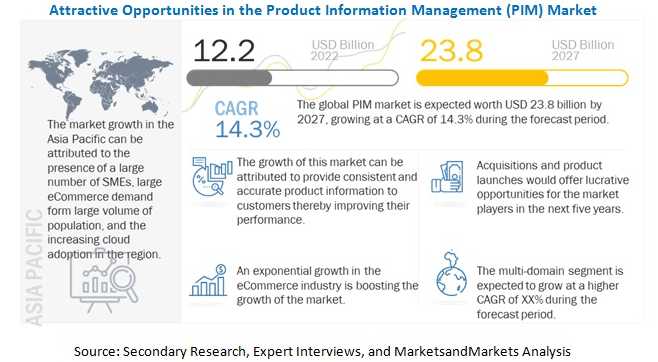Product information management solution centralizes and manages product data across an organization. It ensures data accuracy, enables data enrichment, and facilitates efficient distribution of accurate product data across multiple channels.

In this in-depth guide you’ll learn:
So if you’re ready to go “all in” with product information management, this guide is for you.
Let’s dive right in.
In this chapter, we will go through the history of product information management
We will also cover the definition of product information management, and learn about trends, forecasts, and market growth.
Then, in later chapters, we’ll cover 'How PIM works', PIM benefits, PIM platform features, and more.
In today’s digitized marketplace, managing product information efficiently is critical for seamless operations and customer satisfaction. Product information management (PIM) is at the heart of this process, centralizing and harmonizing all data associated with a company’s products in one place.
This strategic approach not only streamlines data management across various platforms but also ensures high data quality in product catalogs, enhancing product descriptions and strengthening digital asset management. As products evolve and sales channels proliferate, PIM’s role in facilitating data synchronization becomes indispensable, particularly for businesses aiming to create compelling omnichannel experiences.
Embarking on the PIM journey promises significant improvements in operational efficiency and customer reach. From understanding the foundational history of PIM to exploring its core functions like data centralization, enrichment, and distribution, this guide covers the spectrum. It will delve into how PIM integrates with e-commerce sites, supports omnichannel strategies, and the pivotal role it plays in ensuring consistency across product information channels. Furthermore, by outlining the process of selecting the right PIM solution—whether open source or SaaS—and highlighting its future trajectory towards AI and automation, this guide is essential for companies striving to optimize their product information management practices.

The evolution of product information management (PIM) is a fascinating journey that reflects the changing landscape of digital commerce and the growing complexity of managing product data across multiple channels. Here’s a brief overview:
PIM emerged in the early 1990s as businesses sought more efficient ways to manage product data beyond the capabilities of ERP systems ‘item master’.
PIM systems were introduced as centralized repositories to provide a single view of all product information, a significant departure from the fragmented data management practices of the time.
The mid-2000s marked a pivotal moment for PIM with the rise of the internet and eCommerce, necessitating more robust systems to manage and distribute product information across new digital channels.
This period saw PIM systems evolve to collect data from a wider range of internal and external sources, employing data mapping techniques to ensure consistency and accuracy across all channels.
Today, PIM solutions are indispensable for digital commerce, enabling organizations to manage, enrich, and distribute product information seamlessly across e-commerce websites, marketplaces, mobile apps, social media platforms, and even print catalogs.
The technology has its roots in traditional engineering design activities, with the first product data management software, Sherpaworks by Sherpa, released in 1984, laying the groundwork for what would become modern PIM systems.
The transformation of PIM from a simple data repository to a critical component of omnichannel retail strategies underscores its importance in providing cohesive product experiences to customers, improving conversion rates, and automating product creation processes.
Product information management (PIM) is an intricate process designed to centralize, manage, and distribute all product-related data efficiently. This system is pivotal for businesses aiming to streamline their operations and enhance their market presence.
Here are the 10 core aspects of the PIM solution:

At its core, PIM acts as a centralized repository for all product information, ensuring that data is collected, managed, and distributed from a single point of truth 11. This centralization is crucial for maintaining consistency and accuracy across all sales and marketing channels, making PIM the backbone of omnichannel strategies.
Data Collection and Integration: PIM systems ingest data from various sources, organizing it into a cohesive structure. This includes basic product data, digital assets, technical specifications, marketing content, and localized information.
Data Enrichment: Beyond mere data collection, PIM allows for the enrichment of product information with marketing copy, digital assets, and other value-adding content. This process enhances the product’s appeal and marketability.
Data Distribution: One of the key strengths of PIM is its ability to distribute enriched product data across multiple channels. This includes eCommerce platforms, digital marketplaces, print catalogs, and social media, ensuring that all customer touchpoints have consistent and up-to-date information.
Marketing and Sales: For marketing and sales divisions, PIM provides a reliable source of product information that can be quickly accessed and utilized for campaign development, product launches, and sales strategies. This leads to improved operational efficiency and a reduction in time-to-market.
Product Development and Management: PIM streamlines the product development process by offering a platform for cross-functional collaboration. Product managers can easily coordinate with marketing, sales, and design teams to ensure that product information is accurate and comprehensive.
Customer Experience: By ensuring the accuracy, consistency, and richness of product data across all channels, PIM significantly enhances the customer experience. Shoppers benefit from detailed product descriptions, high-quality images, and relevant marketing information, which together drive purchasing decisions..
Product information management (PIM) systems play a pivotal role in conveying how products can be utilized by consumers, thereby enhancing the shopping experience and aiding in informed decision-making. Here’s an overview of how PIM systems manage and present product usage information:
SKUs, Names, and Descriptions: Central to any product listing, these elements provide the basic yet crucial information about what the product is.
Technical Data and Pricing: Detailed specifications and pricing information help consumers assess the product’s suitability for their needs.
Photographs and Videos: Visual content aids in the understanding of product appearance, usage, and features.
User Feedback and Reviews: Sharing experiences from other users can guide potential buyers in their decision-making process.
Instructions and Service Parts: Detailed guides on how to use the product and information on additional service parts enhance post-purchase satisfaction.
Machine Learning Evaluations: PIM systems utilize advanced machine learning mechanisms to evaluate and optimize the presentation of product data, ensuring that the most relevant usage information is highlighted.
SEO Data and Translations: To reach a wider audience, PIM systems manage SEO data and translations, making product usage information accessible to non-native speakers.
Certificates, Logos, and Labels: Certifications and branding elements are managed to build trust and recognition among consumers.
Global Price Management and Promotions: PIM systems enable centralized management of pricing and promotions, ensuring that customers are presented with the best deals.
Inventory and Shipping Information: Real-time management of inventory levels and shipping options helps customers make purchasing decisions based on availability and delivery time.
Multilingual Support and Localized Information: By offering item multilingual support, PIM systems ensure that product usage information is understandable to a global audience, catering to different market segments and regions.
Through the efficient management of product information, including usage data, PIM systems not only streamline the enrichment process but also enable companies to quickly capitalize on products, ultimately boosting customer lifetime value by ensuring a consistent and informative shopping experience across all touchpoints.


Product information management (PIM) systems significantly enhance the handling and presentation of technical information related to products. This facet of PIM is crucial for businesses aiming to provide comprehensive product details to customers and stakeholders. Here’s a breakdown of how PIM manages technical information:
Specifications: Size, weight, color, and dimensions are meticulously managed, ensuring customers have access to detailed product specifications.
Documents and Manuals: Technical documents, including user manuals and assembly instructions, are centralized for easy access and distribution.
Product Attributes: From material composition to energy efficiency ratings, PIM systems aggregate a wide range of product attributes into a single view. This holistic approach supports product innovation by providing a comprehensive understanding of each product.
Elastic Data Models: PIM systems employ flexible data models that scale with business growth. This adaptability is essential for managing the complexity of technical data across diverse product lines and for handling multilingual information, ensuring global reach.
Intelligent Data Relations: By leveraging flexible data models, PIM systems unlock personalized product recommendations and facilitate coordinated cross-selling campaigns. These intelligent data relations are pivotal in automating workflows and enhancing the customer experience by presenting relevant technical information alongside related products.
Centralized Data Hub: PIM acts as a centralized repository for all product information, streamlining the management of technical data and ensuring consistency across multiple sales and marketing channels. This centralization is a cornerstone of effective omnichannel strategies.
Seamless Distribution: With advanced features like data modeling, normalization, and conversion, PIM systems facilitate the efficient distribution of enriched technical data to e-commerce platforms, ERP, CRM, and marketplaces. This ensures that accurate and comprehensive technical information is readily available wherever customers choose to engage.
By efficiently managing and distributing technical information, PIM systems empower businesses to improve data quality, enhance operational efficiency, and ultimately, provide customers with the detailed product insights needed to make informed purchasing decisions.
Integrating product information management (PIM) systems with Digital asset management (DAM) platforms offers a streamlined approach to managing a wealth of digital assets, including images, videos, and documents. This synergy ensures a cohesive brand narrative and efficient asset distribution, crucial for modern digital commerce.
Central Repository: DAM serves as the central hub for all digital assets, simplifying retrieval and storage processes. This consolidation aids in maintaining brand consistency across all marketing and sales channels.
Asset Categorization: With DAM, assets are meticulously organized, tagged, and classified, making it easier for teams to find and utilize relevant media. This organization extends to managing metadata and employing content delivery networks (CDNs) for efficient asset distribution.
Streamlined Communication: By integrating DAM with PIM, businesses optimize product categorization and foster better collaboration between teams. This integration enhances the efficiency of marketing campaigns and product launches.
Brand Consistency and Control: DAM ensures that all digital assets adhere to brand guidelines, enhancing brand consistency. Moreover, it provides control over who can access and distribute these assets, safeguarding against unauthorized use.
Rich Media Management: Beyond static images, DAM handles a broad spectrum of media types, including high-quality images, product videos, 3D views, and PDF documents. This versatility is key to engaging customers across various digital platforms.
Efficient Distribution: DAM systems not only host media and its metadata but also streamline the distribution process. Media transformations and editing occur within the DAM, ensuring that only the most relevant and optimized content reaches the audience.
By integrating PIM and DAM, businesses unlock a powerful duo that enhances the management, organization, and distribution of digital assets. This integration is pivotal in creating compelling product experiences that resonate with customers, ultimately driving engagement and sales. (DM)

In the realm of product information management (PIM), Emotional information stands as a cornerstone for creating compelling and engaging product narratives. Here’s how PIM systems leverage emotional information to connect with customers on a deeper level:
Unified Customer View: PIM systems, integrated with Customer data platforms (CDPs), manage and centralize emotional data alongside traditional product information. This unified approach facilitates personalized, contextualized, and automated experiences, meeting the complex demands of today’s omnichannel consumers.
Streamlined Onboarding for Suppliers: By centralizing emotional information, PIM systems simplify the process for suppliers and data providers to contribute rich, emotive content, ensuring a seamless integration of emotional narratives into product descriptions.
Differentiation through Clarity and Accuracy: Emotional Information within PIM helps businesses stand out by providing clear, accurate, and emotionally resonant product descriptions. This differentiation is key in attracting customers and setting a company apart from its competitors.
Consistency Across Channels: Maintaining product consistency, PIM systems ensure that emotional narratives are accurately conveyed across all channels, from print to targeted social media ads. This consistency is vital for establishing customer trust and fostering a coherent brand image.
Optimized Product Information: Emotional information in PIM supports omnichannel strategies by optimizing product narratives for all channels, thereby driving sales and increasing ROI. Establishing customer trust through consistent product impressions and experiences is central to this optimization.
Personalized Customer Interactions: By managing emotional information effectively, PIM systems enable the personalization of interactions between customers and brands/products. This personalization creates a deeper tie between the product and potential buyers, utilizing emotive language to evoke feelings and connections.
Incorporating emotional information into PIM systems not only enriches product descriptions but also plays a pivotal role in building a more personalized and trusting relationship with customers. By effectively managing and distributing this information, businesses can enhance their omnichannel strategies and personalize customer experiences, ultimately leading to increased engagement and loyalty.


In the digital marketplace, the role of marketing information within the framework of product information management (PIM) systems cannot be overstated. It serves as the linchpin in connecting products with potential buyers through compelling narratives and key selling points. Here’s how PIM systems enhance the marketing aspect of product information:
PIM systems aggregate all marketing-related data into a single database, making it simpler for businesses to manage and update their product catalogs.
This centralization includes essential marketing elements such as product descriptions, unique selling points, target audience insights, and promotional materials.
Integration with DAM ensures that marketing information is consistently paired with the right digital assets, such as images and videos, enhancing the product’s appeal.
This integration aids in maintaining brand consistency and control over how products are presented across various channels.
Product data syndication features within PIM systems allow for the easy distribution of enriched marketing information along with product data to various channels and trading partners, ensuring better market coverage.
Advanced features like SEO data management and multilingual support help in reaching a wider audience and improving sales conversion by making products more discoverable and appealing to diverse customer segments.
The strategic utilization of PIM in managing marketing information leads to numerous benefits, including improved data quality, decreased time-to-market, and enhanced customer experiences. By streamlining internal processes, PIM systems facilitate the delivery of consistent, accurate, and high-quality marketing information, driving stronger customer and omnichannel experiences that ultimately generate more revenue 17. Furthermore, the ability of PIM systems to support sales and marketing divisions by easing asset accessibility across geographies and automating manual tasks simplifies asset management and boosts operational efficiency 5. Through these mechanisms, PIM systems empower businesses to craft compelling product narratives that resonate with consumers and foster emotional connections, thereby elevating the overall marketing strategy.
In the realm of digital commerce, the efficient management of sales information through product information management (PIM) systems is transformative for businesses. Here’s a detailed look at how PIM impacts sales information:
Digital Commerce Framework: PIM systems are engineered to seamlessly integrate with a variety of eCommerce platforms. This integration empowers businesses with automation capabilities and unmatched flexibility, crucial for scaling eCommerce operations efficiently.
Real-time Product Content Updates: Sales layers within a PIM tool exemplify the power of PIM solutions by offering integration with any data source and automating product content updates. This feature ensures that any sales channel, platform, or marketplace receives the most current product information in real time, thus optimizing for SEO and enhancing online visibility.
PIM for Distribution: Specifically designed to aid industrial distributors, PIM systems can manage millions of product SKUs and their attributes. This capability is vital for businesses that deal with extensive inventories and require meticulous organization to prevent data discrepancies.
Key Advantages
Elimination of spreadsheets and manual processes, leading to increased efficiency.
Enhanced supplier data management and multichannel publishing capabilities.
Improved data quality, content distribution, product catalog management, and data governance.
The primary beneficiaries within the distribution business include the eCommerce team, marketing managers, and IT team, all of whom play a pivotal role in managing sales information effectively.
Accurate and optimized product content: Winning on the digital shelf requires more than just presence; it demands optimized product content, accurate information, and a seamless shopping experience. PIM systems are instrumental in achieving these objectives by reducing manual data entry, tracking catalog and inventory data in real time, and providing a centralized database. This not only supports scalability but also improves omnichannel efficiency and enhances marketing campaigns, thereby directly impacting sales positively.
Through the strategic implementation of PIM systems, businesses can revolutionize how they manage and disseminate sales information. By ensuring data accuracy, enhancing operational efficiency, and optimizing for digital commerce, PIM systems enable businesses to leverage their sales information as a powerful tool for growth and customer satisfaction.


Localized information management within product information management (PIM) systems is a transformative approach for businesses aiming to cater to a global market. This section highlights the pivotal aspects of localization in PIM:
Single Source: Localized PIM systems consolidate all product data in one central location, streamlining the translation and localization process across multiple languages.
Best Practices: Ensuring all content originates from the central repository is crucial for maintaining consistency and accuracy in localization efforts.
Market Adaptation: Tailoring product information to fit each market involves adjusting languages, currencies, payment methods, measurements, and prices to meet local consumer expectations.
Translation and Localization Features: PIM systems offer comprehensive tools for multilingual content management, translation workflow management, automation, simplified workflow, integration with translation tools, and quality assurance, ensuring a seamless localization process.
Centralized Information Management: PIM facilitates the centralized management of product information, streamlining translation and localization efforts.
Efficiency and Cost Savings: Implementing PIM for translation and localization leads to improved efficiency, enhanced consistency and accuracy, and significant cost savings, supporting businesses in their global expansion efforts.
By leveraging PIM for localized information management, organizations can effectively meet the unique needs of existing markets and expand into new regions, building strong relationships with potential customers and driving sales. The integration of comprehensive localization tools within PIM systems ensures that businesses can deliver captivating product experiences to a diverse global audience, maintaining consistency while adjusting messaging to specific markets and geographic locations.
Taxonomy within product information management (PIM) systems is a structured approach to organizing product data that ensures information is accessible and understandable to various users across an organization. Here’s how taxonomy plays a vital role in PIM:
Categories and Tags: Products are systematically categorized, and tags are used to group products within these categories, facilitating easy navigation and searchability.
Levels of Detail: Taxonomy operates on multiple levels, accommodating different types of users, from product managers to marketing teams, and enhancing workflows and data flows throughout the organization.
Stakeholder Involvement: The development of a product taxonomy is a collaborative effort, involving key internal stakeholders to ensure it meets the needs of various departments, including onboarding teams and purchasers.
Governance Framework: A robust data governance framework underpins taxonomy, setting rules and guidelines to maintain high-quality data and prevent it from being lost or misused due to an unclear taxonomy structure.
Intuitive Search and Decision Making: A well-structured taxonomy triggers customers’ intuitive search behaviors, making it easier for them to apply filters (e.g., color, dimensions) and facilitating their decision-making process. This not only enhances the customer experience but also provides compelling reasons for them to convert and return.
Automation and Efficiency: PIM solutions automate tasks related to taxonomy management, such as the syndication of product content across sales channels, reducing errors and saving time and resources 41. This automation is especially beneficial for large B2B distributors, ensuring that all SKUs are quickly and easily sold, delivered, and measured.
In essence, effective taxonomy management within PIM systems is not just about organizing product data; it’s about leveraging this organization to improve the omnichannel consumer experience, streamline internal operations, and ultimately, drive business growth through increased conversions, up-selling, and cross-selling.


Design information, as managed by product information management (PIM) systems, is a critical asset for businesses aiming to convey the essence and uniqueness of their products through visual and design elements. Here’s an in-depth look at how PIM handles design information:
Style Guides: These are comprehensive manuals that detail the visual and branding guidelines for products. Style guides ensure that every product aligns with the brand’s visual identity, maintaining consistency across all channels.
Designer Notes: Offering insights into the inspiration, concept, and creative process behind a product, designer notes enrich the product’s story. These notes provide customers with a deeper understanding of the value and craftsmanship of the product, enhancing its appeal.
Gathering and Centralizing: PIM systems act as a central repository for all Design Information, ensuring that style guides and designer notes are accurately collected and managed.
Consistency Across Channels: By distributing this information uniformly across all channels, PIM guarantees that customers receive a consistent brand experience, whether they’re shopping online, in-store, or through a catalog.
Seamless Experience Management: Many digital experience platforms integrate with PIM to manage digital experiences and content across various channels. This ensures high-quality, consistent, and updated product data across customer touchpoints, enhancing the overall digital experience.
Comprehensive Platform Services: Many platforms, offer a range of services including hosting, content management, marketing automation, and more. These services, in conjunction with PIM, provide businesses with the tools to manage not just product information but also the broader digital customer experience.
By leveraging PIM systems to manage and distribute design information, businesses can ensure that their products are presented in a way that resonates with their brand identity and values. This not only enhances the appeal of the products but also strengthens the overall brand experience for customers.
According to Fortune Business Insights, the product information management market is projected to reach USD 12.91 billion by 2029, exhibiting a CAGR of 23.1% during 2022-2029.


In this chapter, we will go through information related to Who needs a PIM solution?
We will also cover the list of industries that could benefit from the PIM solution.
Then, as we go into details, like
What is omnichannel?
How do PIM and omnichannel work together?
Benefits of omnichannel
and more!
Investing in a product information management (PIM) solution is not just a strategic move for businesses; it’s a necessity in today’s digital age for several compelling reasons:

Single Source of Truth: PIM solutions serve as a unified platform, eliminating data silos and ensuring consistency across all channels.
Automated Workflows: AI and automation within PIM software reduce manual errors and increase efficiency, with features like AI-generated product descriptions and automated catalog management.
Streamlined Scalability: PIM solutions facilitate expansion into new markets by ensuring access to accurate, complete, and ready-to-use product information for all channels.
Increased Conversions: Accurate and up-to-date product information reduces barriers to conversion, fostering customer confidence.
Support for Omnichannel Strategies: PIM enables fluid omnichannel strategies, delivering consistent customer experiences across all touchpoints.
Reduced Time-to-Market: Centralized product data allows for quicker product launches, keeping businesses competitive.


Improved SEO: PIM enhances SEO by ensuring that all meta-fields are correctly completed, improving visibility across sales channels.
Internationalization and Multi-market Support: PIM makes it easier for businesses to adapt and expand into new markets and regions, tailoring product information to local languages and customs.
Centralized Digital Asset Management: With capabilities like managing videos, images, and other rich media, next-generation PIMs serve as a centralized hub for all product content.
Identifying the spectrum of businesses that can significantly benefit from implementing a product information management (PIM) system is crucial for understanding its broad applicability and impact. Here’s a detailed look at who needs a PIM:
Companies offering a wide array of products encounter challenges in managing complex product data. PIM systems provide a solution by centralizing and streamlining product information, making it easier to manage and update.
For e-commerce businesses, where product catalogs and marketing strategies are continually evolving, PIM systems are invaluable. They ensure that product information is consistent, up-to-date, and compelling across all sales channels, enhancing the customer shopping experience.
These stakeholders deal with intricate product information that needs to be accurately communicated across the supply chain. PIM systems facilitate this communication, ensuring data accuracy and efficiency, which is essential for maintaining strong partnerships and customer satisfaction.
Organizations with non-uniform IT systems, multiple sales channels, and localization requirements find PIM systems particularly beneficial. PIM helps in harmonizing product information across diverse platforms, simplifying operations, and catering to global market demands.
Businesses that operate with numerous partners, suppliers, distributors, resellers, and franchises require a robust system to manage product information seamlessly. PIM systems enable these companies to maintain accurate product data across all digital and sales channels, ensuring consistency and reliability.
In essence, any organization aiming to streamline operations, enrich customer experiences, and elevate its digital prowess should consider investing in a PIM solution. The versatility and comprehensive capabilities of PIM systems make them an indispensable tool for a wide range of industries and roles, underscoring their significance in today’s digital commerce landscape.
Adaptability to Trends: The fast-paced nature of the fashion industry demands efficient management of product data to quickly adapt to changing trends. PIM and DAM systems streamline this process, enabling brands to stay competitive and responsive.
Complex Data Management: For manufacturers dealing with complex product data, PIM simplifies the management of accurate specifications and timely updates, while DAM organizes and distributes digital assets, facilitating smoother collaboration across teams.
Optimized Content Workflows: In an industry where rapid adaptation to market trends is critical, PIM and DAM systems optimize content workflows, ensuring seamless content delivery across various platforms.
Regulatory Compliance and Patient Outcomes: Managing product information and digital assets for medical devices and pharmaceuticals is crucial. PIM and DAM systems ensure regulatory compliance, improve patient outcomes, and reduce costs.
Wholesale Distribution, Technology, Food & Beverage, Travel & Hospitality: These industries, among others, find PIM solutions particularly beneficial for managing product data, saving time and money, improving customer experience, and promoting data consistency.
Consumer Packaging Goods (CPG), Grocery, Automotive, and Distribution: PIM aids these sectors by decreasing time-to-market, leading to business growth, attaining international standards, and facilitating multi-channel selling.
Spare Parts and Equipment, Horticulture and Agriculture, Wine and Spirits: Industries with specific needs such as managing extensive product variants and data also stand to gain from the comprehensive capabilities of PIM solutions.
In summary, companies across these diverse sectors can leverage PIM solutions to manage product data more effectively, ensuring data consistency across sales and marketing channels, enhancing customer experiences, and driving business growth. The adoption of PIM solutions across these industries underscores their critical role in today’s digital commerce landscape.
Integrating product information management (PIM) with an omnichannel strategy is pivotal for businesses aiming to provide a seamless and consistent customer experience across various channels. This integration is facilitated through several key mechanisms:
Real-Time Interaction with Enterprise Software: PIM systems are designed to integrate seamlessly with a range of enterprise solutions, enabling real-time, two-way interactions. This capability ensures that any changes in product information are immediately reflected across all platforms, from online stores to physical retail outlets, thereby maintaining consistency and accuracy.
Centralized Data Management: At the heart of PIM’s effectiveness in an omnichannel strategy is its role as a centralized repository for all product information. This centralization allows for:
Easy Retrieval and Revisions: Businesses can quickly update product information, ensuring that marketing efforts are consistent across multiple channels.
Single Source of Truth: By centralizing data, PIM systems eliminate discrepancies and ensure that customers find the same accurate and detailed product information, regardless of the channel they use.
Seamless Customer Experience: PIM ensures that customers enjoy a consistent shopping experience, whether they are browsing online, using a mobile app, or visiting a brick-and-mortar store. This consistency is crucial for building customer trust and loyalty, which in turn, drives sales.
Streamlined Inventory Management: By maintaining a unified view of inventory across all channels, PIM systems help retailers manage stock levels more effectively, ensuring that product availability information is always accurate. This capability is essential for meeting customer expectations and reducing the risk of stockouts or overstock situations.
In summary, the integration of PIM systems with omnichannel strategies creates a robust foundation for businesses to deliver a cohesive and enjoyable shopping experience. This integration not only enhances operational efficiency by streamlining the management of product information but also significantly improves customer satisfaction by ensuring consistency and accuracy across all touchpoints.
Omnichannel retailing is a strategic approach that aims to provide customers with a seamless and cohesive shopping experience, regardless of the channel they choose to engage with a brand. This concept is built on several foundational elements:
Websites, ensuring an online presence where customers can browse and shop for products.
Mobile apps, offering convenience for on-the-go shopping and personalized notifications.
Social media platforms, enable brands to engage with customers, showcase products, and direct traffic to their online or physical stores.
Brick-and-mortar stores, provide a tangible shopping experience where customers can physically interact with products.
Ensuring that product information, pricing, promotions, and customer service are uniform across all platforms.
Utilizing universal data to maintain consistency, is crucial for building trust and loyalty with customers.
Prepare the backend systems to deliver a holistic view of the customer relationship, regardless of the channel.
Addressing the challenge of maintaining a single consistent source of data that is accessible to customers through any means of contact with retailer.
The journey to achieving a successful omnichannel strategy involves several steps:
Breaking Down Data Silos: Retailers must integrate their data across all channels to ensure information flow is unimpeded and consistent.
Leveraging Technology: Utilizing platforms and technologies, such as Intel technologies, to collect, store, share, and analyze data from every channel. This technological foundation is essential for deriving business insights and delivering personalized buying experiences.
Maximizing Data Connections: Creating a unified ecosystem that shares data across customer-facing technologies, operational systems, and supporting technology infrastructure. This integration is key to offering personalized sales recommendations and enhancing the customer experience at the moment of transaction.
By focusing on these aspects, businesses can optimize customer engagement and experiences across channels, ensuring digital and in-store operations integrate seamlessly. The future of omnichannel retail lies in designing unique, thoughtful buying experiences that are personalized to customers’ wants and needs, using data analytics to inform targeted campaigns and predict future trends.
The integration of Product Information Management (PIM) with omnichannel strategies brings forth a myriad of benefits, profoundly impacting customer experience, operational efficiency, and overall business growth. Here are the key advantages:
Improved Customer Retention: Businesses see a 13% annual improvement in customer retention, as consistent and accurate product information across channels nurtures customer trust and loyalty.
Increased Revenue: Offering a seamless shopping experience leads to 30% more valuable customers, directly impacting on the bottom line.
Personalized Services: Leveraging PIM for omnichannel strategies enables businesses to offer personalized shopping experiences, including recommendations and promotions tailored to individual customer preferences.
Memorable In-Store Experiences: By integrating interactive technologies and training staff to provide knowledgeable assistance, companies create engaging and memorable in-store experiences.
Increased Operational Efficiency: Centralizing product information management improves operational efficiency by streamlining processes and reducing manual errors.
Improved Inventory Turnover: Accurate and real-time product information across all channels leads to better inventory management, reducing overstock and stockouts.
Digitized Stores and Turbo-Charged Social Media Presence: Embracing digital transformation within physical stores and on social media platforms enhances brand visibility and customer engagement .
Comprehensive View of the Customer Journey: A centralized PIM system offers a 360-degree view of the customer journey, enabling businesses to understand and anticipate customer needs better.
Consumer Insights and Data Collection: Through data collection and analysis, businesses gain valuable insights into consumer behavior, preferences, and trends, allowing for more informed decision-making and strategy development.
Incorporating PIM into omnichannel strategies not only elevates the customer experience but also drives significant improvements in operational efficiency and business intelligence. By ensuring consistency, convenience, and personalization across all channels, businesses can achieve a competitive edge in the digital marketplace.
Integrating Product Information Management (PIM) with an omnichannel strategy is a dynamic approach that ensures a seamless and consistent customer experience across all platforms. Here’s how they work together effectively:
Seamless Buying Experience: Omnichannel commerce is designed to offer a seamless buying experience, with each sales channel maintained independently by distinct divisions of the brand, ensuring that customers receive the same quality of service regardless of the platform they choose to purchase on.
Data Silo Removal: PIM plays a critical role in removing data silos, enabling efficient workflows for sharing product information both internally and externally. This ensures that all channels are updated in real time, maintaining consistency in product information.
Unified Customer Experience: Omnichannel activity connects consumer touchpoints, providing a consistent and joined-up experience regardless of which path customers follow throughout the purchase process. This consistency is crucial for building trust and loyalty with customers 60.
Rich Product Experiences: PIM helps generate rich product experiences across all channels and builds brand consistency with digital assets. This is vital for engaging customers effectively in marketing and sales efforts, enhancing the overall customer experience.
System Integration: PIM integrates with existing systems, reducing the workload and complexity of managing product data for IT departments. This integration is essential for the agility needed in today’s fast-paced market, enabling brands to quickly adapt sales and communication strategies for a consistent and positive customer experience.
Adaptability: Agility PIM brings products to life across every channel, allowing a brand to integrate, optimize, and syndicate product information quickly, accurately, and efficiently. This adaptability is key to meeting the expectations of modern consumers who seek a uniform brand experience across all channels.
By leveraging the strengths of PIM in conjunction with an omnichannel strategy, businesses can ensure a seamless integration of product information across all customer touchpoints. This not only enhances the customer buying journey but also provides a solid foundation for brands to adapt and thrive in the evolving digital landscape.
In this chapter, we will be explaining
Scenarios highlight when businesses should consider implementing a PIM system
The benefits of using a PIM solution
Businesses encounter several pivotal moments when the need for a product information management (PIM) solution becomes not just apparent but essential. The following scenarios highlight when businesses should consider implementing a PIM system:
For businesses grappling with extensive product ranges, managing data becomes increasingly complex. PIM solutions are indispensable for those with many SKUs, streamlining data flow with third-party systems and enabling effective omnichannel publishing.
The complexity of managing many product versions and variations is significantly reduced with a PIM system, providing a centralized location for all product information, including variations.
Inaccurate or inconsistent product data across channels and systems can lead to confusion, errors, and operational inefficiencies. PIM software addresses these issues by streamlining data management and reducing manual data entry and reconciliation.
Businesses often struggle with balancing product information across multiple storefronts, geographic locations, currencies, and marketplaces. PIM systems offer a solution by simplifying the management of product data across different platforms, ensuring accuracy and efficiency.
Expanding into new markets or selling through new channels requires adapting product information to different languages, currencies, and regulatory requirements. PIM systems simplify this process, enabling businesses to quickly adapt to market changes and meet customer expectations for accurate and up-to-date product information across all channels.
The shift towards omnichannel sales and marketing necessitates a PIM system for centralizing and synchronizing product data across online and offline channels. This ensures consistency in pricing, promotions, and product availability information, crucial for maintaining brand integrity and customer trust.
In each of these scenarios, the implementation of a PIM solution facilitates transformation and requires comprehensive changes in business processes, people, and organization. By addressing these challenges head-on, businesses can unlock the full potential of their product data, leveraging it for cross-selling, upselling, and personalization, ultimately leading to better business performance and customer satisfaction.
The benefits of implementing a Product Information Management (PIM) solution are multifaceted, directly impacting e-commerce performance, operational efficiency, and customer satisfaction. Here’s a closer look at these benefits:
Centralization of Product Data: PIM solutions serve as the central repository for all product information, reducing data silos and promoting data sharing across the organization. This centralization enforces data standardization and features integration capabilities with other enterprise systems, enhancing operational efficiency.
Efficient Data Management: The consolidation of product data enables teams to save considerable time in their daily tasks, eliminating the need to search for the right product information across different systems and platforms.
Faster Time-to-Market: By streamlining the onboarding process for new products and accelerating updates, PIM significantly reduces the time needed for input, verification, and enrichment of product data, enabling quicker product launches and faster response to market trends.
Improved Data Quality: High-quality digital information ensures that customers have access to accurate and consistent product details across various channels, enhancing the shopping experience and customer satisfaction 81 76. Superior data quality validates and guarantees the quality of existing data, ensuring only quality-assured data is released.
Better Buying Experience: Advanced PIM features streamline internal processes, provide consistent, channel-ready product content, and enhance efficiency and customer trust, leading to a better overall buying journey.
Increased Return on Experience (ROX): Minimizing returns and cart abandonment rates, PIM solutions enhance transparency, scalability, and the overall buying journey, boosting the Return on Experience for customers.
Improved Conversions and Increased Revenue: Accurate product information speeds up customers’ buying decisions, leading to improved conversions. Together with enhanced customer experience and operational efficiency, these factors contribute to increased revenue and a significant return on investment across the business.
Internationalization and Multi-market Expansion: PIM platforms equip businesses with the tools to quickly internationalize their brand and venture into new markets by adapting product information to local languages and regulatory requirements, thereby expanding their global footprint.
By addressing the complexities of product information management, PIM solutions not only optimize internal operations but also significantly improve the customer experience and position businesses for competitive advantage and growth in the digital marketplace.

In the retail industry, the implementation of product information management (PIM) solutions has revolutionized how businesses manage their product catalogs, ensuring consistency, accuracy, and efficiency across all sales channels. Here’s a closer look at the transformative impact of PIM in the retail sector:
Central Source of Truth: PIM provides a unified platform for all incoming product information, making it the single source of truth. This ensures that product details are consistent and accurate across various sales channels, significantly reducing discrepancies that could lead to customer dissatisfaction.
Brand Consistency: By maintaining accurate information on all sales channels, PIM plays a crucial role in preserving brand consistency. This accuracy extends to pricing, sizes, and materials, thereby minimizing product returns and enhancing customer trust.
Rapid Updates and Localization: The dynamic nature of retail requires quick updates to product data. PIM allows for efficient management of constantly updated product data, enabling swift optimizations and tweaks. Moreover, it facilitates the launch of new products and expansion into other regions by storing localized content, ensuring streamlined processes and uniform customer satisfaction.
Reduced Product Returns: Accurate product information directly correlates with reduced product returns. PIM ensures that customers receive what they expect, improving the overall shopping experience and reducing the logistical and financial burdens associated with returns 86.
Efficient Distribution Across Channels: PIM enables the quicker creation of channel-specific product content with minimal chances for inaccuracies. This capability is crucial for efficient product distribution across multiple sales channels, ensuring that customers have access to the latest product information, regardless of how they choose to shop.
In the fast-paced world of e-commerce, Product information management (PIM) systems have become indispensable tools for managing product data efficiently and effectively. Here are key ways PIM transforms the e-commerce industry:
Single Source of Truth: Acting as a central hub, PIM collects various types of data including media files, product usage data, and emotional data, ensuring that all product information is consistent and accessible from a single location.
Synchronization Across Platforms: By syncing product content across e-commerce platforms, ERP, OMS, and third-party integrations, PIM eliminates discrepancies and enhances omnichannel efficiency.
Reduction in Manual Data Entry: Automating the import, validation, enrichment, and publication of detailed product information, PIM systems significantly reduce manual data entry, minimizing errors and freeing up valuable resources.
Improved Omnichannel Efficiency: PIM supports scalability and improves omnichannel efficiency, ensuring that marketing campaigns are more effective and reach a wider audience.
Targeted Product Recommendations: Leveraging product data insights, PIM enables e-commerce businesses to deliver targeted product recommendations and tailor marketing campaigns to specific customer segments, enhancing the shopping experience.
Increased Revenue and ROI: By providing consistent, quality product information everywhere, PIM systems instill customer confidence, leading to higher conversion rates, fewer product returns, more revenue, and better ROI.


In the healthcare industry, the deployment of product information management (PIM) systems addresses critical challenges and streamlines operations, ensuring compliance with stringent regulatory standards and enhancing patient care:
Healthcare professionals rely on efficient supply chains to meet evolving health and safety requirements.
GS1 has standardized health product descriptions, collaborating with healthcare professionals to ensure compliance across medicines, medical devices, and pharmaceutical products.
PIM platforms facilitate the management and exchange of crucial product information within the healthcare ecosystem, including pharmaceutical laboratories and medical device manufacturers.
A PIM solution drastically reduces the time required for creating and disseminating product files, eliminating the need for re-entry and ensuring that all stakeholders have access to consistent, up-to-date information.
By centralizing product data and patient information, PIM systems ensure real-time updates and sharing across channels, improving collaboration and reducing the risks of human error.
PIM software enforces safety requirements, providing healthcare personnel with essential product data through software programs, thereby adhering to laws and minimizing the possibility of data leaks.
PIM increases ROI and reduces costs by optimizing expenses, facilitating the procurement of equipment and medication, and enhancing collaboration between IT professionals and physicians.
Efficient inventory management through PIM allows staff to maintain stock levels based on need, ensuring that products are used within their shelf life and adhering to safety standards.
Central management of product information via PIM systems enables healthcare companies to meet regulatory requirements, manage multilingual content, and improve productivity through automated processes.
These points illustrate the profound impact of PIM solutions in the healthcare industry, from ensuring compliance and operational efficiency to directly contributing to improved patient care and cost savings.
Here are some of the important core functions of PIM solutions which include,
Data centralization
Data enrichment
Data distribution
The core functions of a product information management (PIM) solution are crucial for businesses aiming to streamline their product information management and enhance their omnichannel presence. These functions can be broadly categorized into three main areas:
The core function of data centralization within a product information management (PIM) solution is multifaceted, addressing several key operational challenges and streamlining processes for businesses.
Here’s how it works:
PIM acts as a centralized hub for all product data, significantly reducing data silos and promoting efficient data sharing both internally and across company boundaries.
It enforces data standardization and incorporates workflow management for collaborative creation, approval processes, and integration with systems like ERP and e-commerce platforms, ensuring data consistency and accuracy across all channels.
Tailored interfaces allow for the integration of suppliers and service providers, streamlining the onboarding of new products and reducing the time needed for input, verification, and enrichment of product data.
Superior data quality is maintained through rule-based workflows that check the completeness and quality of existing data, facilitating accurate and detailed product information, including high-quality images and multimedia content.
Equipped with translation features, PIM can alleviate challenges and minimize costs associated with localization, ensuring that product information meets local and international regulations.
The enriched and accurate product data enables seamless integration with next-gen technologies for personalization and customization, facilitating consistent and accurate distribution of product information across different platforms such as online stores, marketplaces, social networks, and printed catalogs.
Through these mechanisms, data centralization in PIM not only enhances operational efficiency by automating repetitive tasks and simplifying complex processes but also ensures that customers receive the same product information regardless of the channel they use, significantly improving the quality and detail of product information.
Data enrichment within product information management (PIM) systems is a critical process that significantly enhances the quality and comprehensiveness of product data. This process involves several key steps and offers a range of benefits to businesses, including:
Key Steps in data enrichment:
Importing: Gathering and importing product data from various sources into the PIM system.
Transforming: Adjusting and converting the imported data into a standardized format suitable for further processing.
Enriching: Enhancing product data by adding valuable content, improving its accuracy and quality, and ensuring that product descriptions and images are unique and engaging.
Distributing: Once enriched, the product data is ready to be distributed across multiple sales channels, ensuring that customers have access to detailed and compelling product information.
In product information management (PIM), data distribution is a pivotal function that ensures product information reaches the intended platforms and channels accurately and efficiently. This process encompasses several key activities:
Efficient Syndication and Exporting
PIM systems facilitate the syndication of product information across a wide array of channels, including e-commerce platforms, marketplaces, and social media networks, ensuring a consistent brand presence.
Custom feeds can be created within PIM to meet the specific requirements of different sales channels, allowing for tailored product presentations that cater to the unique needs of each platform.
Challenges and Solutions in Product Content Distribution
Businesses often face challenges such as maintaining data quality and consistency, adhering to channel-specific requirements, and ensuring the security of data during distribution.
Solutions like the Gepard PIM Tool streamline these processes, enhancing operational efficiency by addressing these challenges head-on. This tool automates data integration and distribution, ensuring data quality and consistency across channels.
Monitoring and Analytics
PIM systems provide tools for tracking the performance of product content across channels, offering valuable insights into data distribution effectiveness.
These insights include understanding specific parts of the data that perform well, identifying outliers, and analyzing central tendencies, enabling businesses to make informed decisions and optimize their product information strategy.
By leveraging the capabilities of PIM for data distribution, businesses can ensure that their product information is not only accurately disseminated across all desired channels but also optimized for performance, leading to increased visibility, customer engagement, and ultimately, sales.
In the intricate ecosystem of modern business operations, a product information management (PIM) solution plays a pivotal role, acting as the central nervous system for product content management. Its integration within the business ecosystem is multi-dimensional, spanning across various platforms and systems to ensure seamless data flow and consistency:
Integration with Core Business Systems:
Ecommerce Platforms: PIM solutions sync effortlessly with ecommerce platforms, ensuring that product listings are up-to-date, accurate, and consistent across online storefronts.
Enterprise Resource Planning (ERP) and Order Management Systems (OMS): By integrating with ERP and OMS, PIM ensures that product information is in sync with stock levels, pricing, and order processing, facilitating seamless backend operations.
Third-party Integrations: PIM extends its capabilities by integrating with third-party systems such as marketplaces, social media channels, and data feeds, broadening the reach of product information and enhancing customer engagement.
Enhancing Operational Efficiency and User Experience:
A PIM solution not only centralizes product data but also enriches and standardizes it, ensuring that all stakeholders, from marketing to sales and customer service, have access to reliable and consistent product information. This significantly improves operational efficiency and reduces errors.
Key features such as data modeling, normalization, and conversion, alongside advanced search tools and bulk product editing, empower businesses to manage their product catalogs effectively, improving the user experience both internally and externally.
Supporting Scalability and Omnichannel Efficiency:
As businesses grow and expand into new markets, PIM solutions offer the scalability needed to manage increasing volumes of product data and complexity. This supports businesses in maintaining their competitive edge in a dynamic market environment.
The centralization and efficient management of product information through PIM play a crucial role in enhancing omnichannel efficiency. By ensuring consistent product information across all channels, PIM solutions enhance marketing campaigns and contribute to a cohesive brand experience, driving customer satisfaction and conversions.
In essence, a PIM solution is not just a tool for data management; it is an integral component of the business ecosystem that bridges the gap between various operational areas, ensuring that product information flows seamlessly from suppliers to end consumers. Its integration with systems such as POS, WMS, OMS, and retail insights modules further underscores its significance in optimizing business operations and facilitating growth.
Product information management (PIM) solutions are equipped with a diverse range of features designed to optimize the management and dissemination of product information across multiple channels. These features include:
Advanced-Data Management Capabilities:
Product Data Aggregation and Import Features: Support for automatic or manual data import from various sources like ERP, PLM, DAM, and MDM, accommodating formats such as Excel, CSV, and XML. This ensures a seamless flow of product information into the PIM system.
Central Repository for Product Data: Acts as a single source of truth for all product-related data, managing multiple product catalogs and offering versioning to track changes over time. This centralization is crucial for maintaining consistency across sales channels.
Standardization and Classification of Product Data: Facilitates the organization of products by attributes, grouping attributes into attribute groups, and forming product families. Utilizes classification systems such as ECLASS, ETIM, UNSPSC, and GPC for global standardization.
Enhanced Usability and Efficiency:
Quick Product Search and Filtering: Allows for efficient navigation through catalogs, categories, and characteristics with unlimited filters, enhancing the speed and accuracy of product information retrieval.
Bulk Editing Capabilities: Enables mass updates across numerous products for attributes, product affiliations, and status changes, significantly saving time and ensuring consistency in product information.
Roles and Access Rights: Customizable roles and permissions for employees, departments, and partners, ensuring secure access to product information based on the user’s role in the organization.
Collaboration and Workflow Optimization:
Organization of Cooperation between Users: Features such as commenting, task creation, and notifications facilitate collaboration among team members, streamlining the product information management process.
Workflow Management of Product Descriptions: Automates the enrichment process, monitors task statuses, and ensures the validation of product information completeness and correctness, enhancing operational efficiency.
These features, combined with AI-powered enhancements like natural language generation, multimedia product asset management (DAM), and digital shelf analytics, position PIM solutions as indispensable tools for businesses aiming to improve their product information processes, drive sales, and enhance customer experiences across multiple channels.
In this chapter, we will be explaining
'Step by step process in getting started with Commport PIM solution

Getting started with a product information management (PIM) solution involves a strategic and structured approach to ensure seamless integration and maximization of its benefits. Here’s a step-by-step process tailored to guide businesses through the initial phase of implementing a PIM solution:
Define and Document Your PIM Use Case: Begin by identifying the existing operational gaps that a PIM solution can address. Establish how implementing a PIM system will yield the desired business results, enhancing efficiency and improving product data management.
Conduct a Thorough Audit of Your Existing Product Data: Assess the current state of your product information to identify inconsistencies, duplicates, and missing information. This step is crucial for understanding the scope of data cleansing and standardization required.
Build a Team: Assemble a cross-functional team that includes members from marketing, sales, product, IT, and legal departments. This team will oversee the PIM initiative from inception to completion, ensuring that all aspects of the business are considered.
Evaluate PIM Packages: Research and compare different PIM packages based on your specific requirements, budget, scalability, and ease of integration.
Customize, Deploy, and Integrate: Establish strong data governance policies and utilize data quality technology. Customize the PIM solution based on your organization’s unique requirements and data model. Ensure seamless integration with existing systems like ERP, CRM, and eCommerce platforms.
Pilot Test and Scale: Adopt a pragmatic approach by planning the implementation journey in phases. Start with a pilot test to ensure the system works as expected, then gradually scale up, ensuring value delivery at each stage. This incremental strategy demonstrates how PIM integrates seamlessly into existing processes.
Adopt a Change Management Initiative: Implement functional and technical training programs for your team to ensure smooth adoption of the PIM system. Change management is critical for facilitating the transition and maximizing the use of the new system.
Monitor Performance: Continuously monitor the performance of the PIM system post-deployment. Address any issues promptly to maintain operational efficiency and data accuracy. This ongoing evaluation is key to ensuring that the PIM solution meets the evolving needs of the business.
By following these steps, businesses can effectively navigate the complexities of implementing a PIM solution, laying a strong foundation for improved product information management and enhanced omnichannel experiences.
In this chapter will go over some of the challenges faced while implementing and using the PIM solution.
We will also talk about some future trends in PIM solutions and the use of AI & automation
Implementing a product information management (PIM) solution comes with its own set of challenges that businesses need to navigate to ensure successful deployment and utilization. These challenges include:
Handling Large Amounts of Data: Mid-sized enterprises and large corporations face the daunting task of managing extensive content, including product details from a wide range of products, services, distributed vendors, and sales channels. A PIM system aids in organizing this distributed data, standardizing product information in a centralized location.
Error-Prone Manual Processes: The manual uploading of data for thousands of products into spreadsheets is not only time-consuming but also prone to errors, leading to inaccuracies and inconsistencies in product information. A PIM solution enhances spreadsheet accuracy by enabling bulk data entry and workflow creation.
System Integration Complexities: Integrating a PIM system with existing enterprise systems such as ERP, CRM, and eCommerce platforms can be complex due to varying data structures, formats, or APIs. Employing API integrations, middleware solutions, or pre-built connectors facilitates data exchange between systems.
Lack of Transparency Among Departments and Teams: As businesses expand, departments often become isolated, failing to share information, tools, goals, and priorities, which leads to inefficiency and duplicity in work. Open-source PIM software eliminates these communication gaps by facilitating interaction among teams.
Scalability Concerns: As businesses grow, the need for a PIM system to flexibly accommodate increasing data volumes, diverse product catalogs, and evolving business needs becomes crucial. Ensuring the PIM solution’s scalability is essential for long-term success.
Resistance to Change and Lack of User Adoption: Employees may resist the introduction of a new PIM system due to changes in processes and workflows. Overcoming this resistance involves investing in change management strategies, involving key stakeholders from the beginning, and providing comprehensive training and ongoing support.
Addressing these challenges requires a strategic approach, including thorough planning, stakeholder involvement, and leveraging technology solutions that streamline integration and data management processes.
The future of product information management (PIM) solutions is poised for transformative growth, leveraging the power of Artificial Intelligence (AI) and automation to redefine how businesses manage and utilize product data. The integration of these technologies promises to enhance efficiency, accuracy, and customer engagement through several key advancements:
Automated Data Processing: AI-powered PIM systems can handle multiple data structures and file formats, automatically decoding and importing data, thus simplifying the data cleansing and editing process.
Content Creation: Utilizing AI to generate compelling product descriptions and engaging content by analyzing product attributes and customer behavior, significantly reducing the time spent on content creation.
Advanced Data Analysis: Machine learning algorithms will continually improve data accuracy by identifying discrepancies within vast datasets, ensuring reliable, error-free data, and providing actionable insights by analyzing customer interactions.
Personalized Recommendations: AI-driven solutions will offer tailored product recommendations by analyzing vast datasets, including purchase history and behavior, enhancing context-based marketing and customer satisfaction.
Dynamic Interaction: Integration with AR and VR technologies, alongside voice-activated commerce, will revolutionize the retail landscape, offering immersive and interactive product experiences.
Workflow Automation: AI can automate repetitive tasks such as attribute mapping, SKU matching, and dynamic pricing, allowing teams to focus on more strategic work.
Real-Time Analytics and Insights: AI-driven PIM systems will provide real-time data analytics, enabling businesses to make agile and informed decisions, optimize inventory levels, and adjust prices based on competitive analysis.
As the PIM market is projected to reach $12.91 billion by 2029, these advancements underscore the critical role of AI and automation in shaping the future of product information management, offering businesses unprecedented efficiency, market responsiveness, and the ability to deliver personalized customer experiences.
Product Information Management (PIM) is not just a competitive advantage—it’s a necessity. By centralizing and streamlining product data, businesses can improve operational efficiency, ensure accuracy across channels, and enhance customer satisfaction. Whether you’re a retailer, manufacturer, or distributor, adopting a robust PIM system empowers your organization to navigate the complexities of omnichannel commerce and meet evolving market demands.
At Commport Communications, we understand the critical role that PIM plays in driving business success. Our solutions are designed to help you unlock the full potential of your product data, providing the tools you need to stay ahead in an increasingly digital landscape.
Ready to transform your product data management? Explore Commport’s innovative PIM solutions and discover how we can support your business goals.
Businesses should evaluate scalability, ease of integration, user-friendliness, support for multi-language and multi-channel capabilities, customization options, and overall cost when selecting a PIM solution.
Yes, PIM systems are designed to integrate with e-commerce platforms, ERP systems, digital asset management (DAM) tools, and marketplaces like Amazon or eBay. This ensures seamless data flow and efficient operations.
Benefits include:
While ERP systems focus on internal processes (like inventory and finance) and CRM systems manage customer interactions, PIM is dedicated to managing and distributing product information. It integrates with ERP and CRM to provide comprehensive data management.
PIM systems are used by businesses in industries like retail, manufacturing, and e-commerce. They are particularly valuable for marketing teams, product managers, and supply chain professionals who need to maintain consistent product data across channels.